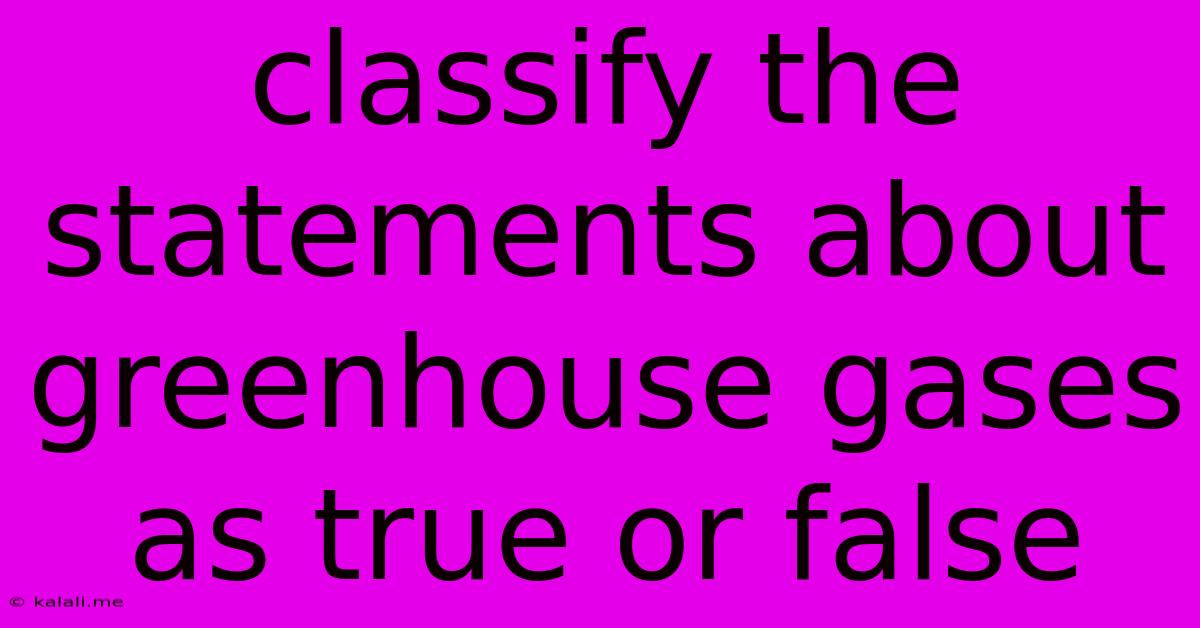Classify The Statements About Greenhouse Gases As True Or False
Kalali
Jun 15, 2025 · 3 min read

Table of Contents
Classifying Statements About Greenhouse Gases: True or False
Greenhouse gases (GHGs) are a hot topic, and understanding them is crucial to comprehending climate change. This article will classify several statements about greenhouse gases as true or false, providing explanations to clarify any misconceptions. Accurate understanding of GHGs is essential for informed discussions about environmental policy and sustainable practices.
What are Greenhouse Gases?
Before diving into the true/false statements, let's briefly define greenhouse gases. These are gases in the Earth's atmosphere that trap heat. They allow sunlight to pass through the atmosphere but prevent some of the heat from radiating back out into space, thus warming the planet. This natural process is essential for life on Earth, but human activities have significantly increased the concentration of these gases, leading to global warming and climate change.
True or False Statements about Greenhouse Gases:
Let's examine some common statements regarding greenhouse gases and determine their accuracy.
1. Statement: Carbon dioxide (CO2) is the most significant greenhouse gas contributing to human-caused climate change.
Verdict: True. While other GHGs exist, CO2 is the primary contributor to anthropogenic (human-caused) global warming. Its abundance in the atmosphere, coupled with its long lifespan, makes it a major driver of climate change. Burning fossil fuels, deforestation, and industrial processes are major sources of CO2 emissions.
2. Statement: Methane (CH4) is a more potent greenhouse gas than carbon dioxide (CO2).
Verdict: True. Methane has a much higher global warming potential (GWP) than CO2 over a shorter time period. While a single methane molecule doesn't trap as much heat as a CO2 molecule, methane's higher GWP means it contributes significantly to warming, especially in the short term. Agricultural practices, natural gas leaks, and landfills are major methane sources.
3. Statement: Water vapor (H2O) is not considered a greenhouse gas.
Verdict: False. Water vapor is actually the most abundant greenhouse gas in the atmosphere. However, it's primarily a feedback mechanism rather than a direct driver of climate change. Warming temperatures increase evaporation, leading to more water vapor in the atmosphere, which further enhances the greenhouse effect. This is a positive feedback loop.
4. Statement: Nitrous oxide (N2O) is a powerful greenhouse gas with a long atmospheric lifetime.
Verdict: True. Nitrous oxide has a significantly higher GWP than CO2 and remains in the atmosphere for a considerable time. Agricultural activities, industrial processes, and the burning of fossil fuels are all sources of N2O emissions.
5. Statement: Reducing greenhouse gas emissions will have no significant impact on global warming.
Verdict: False. Reducing GHG emissions is crucial to mitigating climate change. While the effects of past emissions will continue to be felt for some time, significant emission reductions can help slow the rate of warming and prevent the most severe consequences of climate change. Transitioning to renewable energy sources, improving energy efficiency, and adopting sustainable agricultural practices are critical steps.
6. Statement: All greenhouse gases are equally harmful to the environment.**
Verdict: False. Different GHGs have varying global warming potentials and atmospheric lifetimes. While all contribute to warming, their relative impacts differ, necessitating targeted emission reduction strategies.
7. Statement: Planting trees can help reduce greenhouse gas concentrations in the atmosphere.**
Verdict: True. Trees absorb CO2 during photosynthesis, effectively removing it from the atmosphere. Reforestation and afforestation projects can play a significant role in mitigating climate change, although they are not a substitute for reducing emissions from other sources.
Conclusion:
Understanding the nuances of greenhouse gases is vital for addressing climate change effectively. By dispelling misconceptions and clarifying the facts, we can work towards informed solutions and a more sustainable future. This requires collaborative efforts across governments, industries, and individuals to adopt environmentally conscious practices.
Latest Posts
Latest Posts
-
Which Of The Following Is Not A Characteristic
Jun 15, 2025
-
Cardiac Muscle Differs From Skeletal Muscle In That
Jun 15, 2025
-
Which Sentences Are Punctuated Correctly Select 3 Options
Jun 15, 2025
-
Which Of The Following Is An Endogenic Process
Jun 15, 2025
-
A Battery Converts What Type Of Energy To Another
Jun 15, 2025
Related Post
Thank you for visiting our website which covers about Classify The Statements About Greenhouse Gases As True Or False . We hope the information provided has been useful to you. Feel free to contact us if you have any questions or need further assistance. See you next time and don't miss to bookmark.